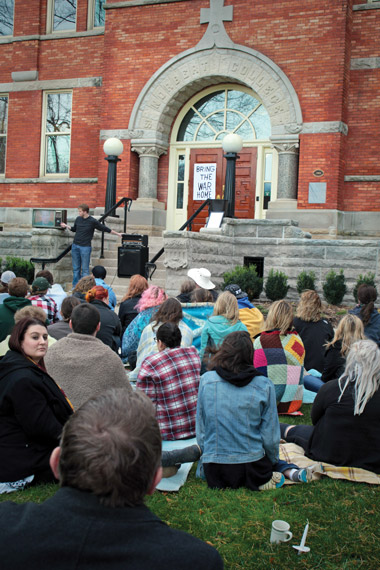Revisiting History/An Era of Protest

Combine sleuthing with theatrical staging, photographic knowledge, historical research, discussion, planning, publicity, collaboration and fortuitous timing.
That’s what it took for students in the Contemporary Photographic Strategies class taught by Brandon Bauer (Art) to recreate a historic photo of a 1969 campus peace protest.
Early in the semester, as students learned about various contemporary photographers, they were drawn to Carrie Mae Weems’ recreations of historic photos, says Bauer, co-editor of the book “Peace Signs: the Anti-War Movement Illustrated.”
An archives’ search turned up several photos of campus peace demonstrations during the Vietnam War, including one students especially liked, of a bonfire in front of Main Hall. They quickly realized they would not receive permission to restage a bonfire. Instead they chose a photo set at Main Hall, an iconic symbol of campus.
Why not just study the photo?
It’s the difference between learning by looking and “learning from what was happening by actually putting the work in to learn from it,” says Dayna Seymour ’16.
Plus, by recreating a photo, they could teach school history to others, says Becky Ratajczyk ’17.
Some class members reported having poignant family discussions about the war.
They determined that the photo probably was taken in November 1969 based on how students were dressed, a TV showing President Nixon speaking and “Bring the War Home” signs, a slogan first used the previous month.
A check with the alumni office and faculty teaching then turned up nothing.
ROTC archives showed that SNC protests were more peaceful than at some campuses and focused on policies, not soldiers.
The class worked with the theatre discipline on costumes and props and spent a lot of time finding the right camera angle and focal length.
They publicized the photo shoot to recruit more people, ending up with 25, compared to 40 in the original.
When the college scheduled a panel discussion on the Paris attacks, students shot the photos two hours earlier than planned in hopes some attendees would join them.
One student who did, Tanyssa Behnke ’17, posted a photo on Instagram, including the hashtag #communio.
Bauer says he liked how “she made that direct connection with those ideas of the college and the Norbertine community, and that connection between students nearly 50 years ago and students of today wrestling with the issues of their time.”
The day after the restaging, the class talked about how their restaging of a peace vigil “became a real peace vigil because of the Paris attacks and because of the people who came and participated directly after the panel. That was really powerful. We talked about how they were two completely different eras and two completely different conflicts with their own unique complexities, but there was this real connection between that time and this time, and students really wanting to get together to have a moment, to have a vigil.”
An exhibit this semester included the original photograph, a large unedited copy of the recreation, copies of each student’s edited photo, their notes, the video loop and other shoot-related items.
March 14, 2016











